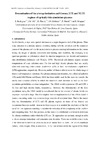Please use this identifier to cite or link to this item:
https://accedacris.ulpgc.es/jspui/handle/10553/46056
| Title: | Determination of the average ionization and Corona, LTE and NLTE regimes of optically thin aluminium plasmas | Authors: | Rodríguez, R. Gil, J. M. Florido, R. Rubiano, J. G. Martel, P. Mínguez, E. |
UNESCO Clasification: | 220410 Física de plasmas | Keywords: | Aluminium plasmas | Issue Date: | 2007 | Project: | Determinación de Propiedades Radiativas, Termodinamicas y Diagnosis Espectroscopica de Plasmas de Interés Científico-Tecnológico | Journal: | 34th EPS Conference on Plasma Physics 2007, EPS 2007 - Europhysics Conference Abstracts | Conference: | 34th European Physical Society Conference on Plasma Physics 2007, EPS 2007 | Abstract: | As it is known, x-rays have special relevance as a major diagnostic tool of the plasma. Thus, x-ray emission is a primary process occurring during both the evolution and the expansion phases of the plasma and it is the main detectable process carrying information on the plasma during the stages of plasma production and heating, and, therefore, the emerging x-ray spectrum provides us information about the electron temperature, ion density and ionization state distribution (Salzmann and Wendin, 1978). Theoretical calculations require accurate computations of x-ray radiation rates. For low and high density plasmas they are usually calculated assuming either corona equilibrium (CE) or local thermodynamic equilibrium (LTE) approaches, respectively. However, neither of them is able to cover the whole range of density and temperature variations. For plasma intermediate densities, the collisional radiative (CR) model (McWhirter and Hearn, 1963) has been widely used. In this work we consider the steady state situation (CRSS) in which the ionization state densities as well as the level population probabilities are time independent. The CRSS model approaches CE and LTE in the low and high density limits, respectively. However, the determination of the level populations using the CRSS model is complicated due to the number of atomic levels and processes involved is huge. This fact implies that the implementation of the CRSS model in plasma simulating codes may consume large amounts of computer time. That is the reason why the determination of LTE and CE plasma regimes in terms of the density and temperature becomes useful, because in these regions it is avoided the resolution of the full set of the rate equations entailing a considerable reduction of the complexity of the problem and computing time. With this purpose, in this work it is established a criterion to determine the plasma conditions under which the LTE and CE approaches are accurate enough in order to obtain average ionizations and ionization state densities. There are available other criteria in the literature to determine when an ion or an atomic level is under LTE or CE conditions (Griem, 1964; Cooper, 1966; Eliezer et al., 1978) Our criterion states the regime of the whole | URI: | https://accedacris.ulpgc.es/handle/10553/46056 | ISBN: | 9781622763344 | Source: | 34th EPS Conference on Plasma Physics 2007, EPS 2007 - Europhysics Conference Abstracts,v. 31, p. 1030-1033 |
| Appears in Collections: | Actas de congresos |
Page view(s)
50
checked on May 4, 2024
Download(s)
17
checked on May 4, 2024
Google ScholarTM
Check
Altmetric
Share
Export metadata
Items in accedaCRIS are protected by copyright, with all rights reserved, unless otherwise indicated.
